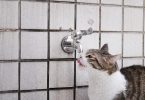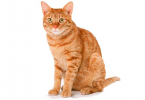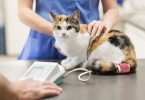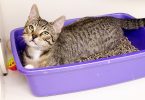Pedialyte is a drink used to replace fluids and minerals that have been lost during dehydration, causing a vitamin and mineral deficiency. Usually this will accompany symptoms such as vomiting and diarrhea. The drink is a great source of electrolytes and sugars, particularly glucose and sucrose. They are very quickly absorbed into the blood stream and can provide a very rapid boost in blood sugar levels and relief from the more acute symptoms associated with dehydration. But is Pedialyte safe for cats?
Who can benefit from taking Pedialyte?
Originally designed for children who were ill, Pedialyte is now also used by adults whether dehydrated from illness, exercise or perhaps those who have enjoyed “too many drinks the night before” to reduce the effects of a hangover.
While we can hopefully presume that your cat does not have a hangover, if it is showing signs of dehydration or refusing to drink any water is it okay to give your cat pedialyte?
Can you give Pedialyte to cats?
In short, yes it is fine and even beneficial as long as you follow some simple rules.
How to tell if your cat is dehydrated?
Along with the usual fluid loss due to hot weather or exercise, vomiting and diarrhea are the two main culprits when it comes to dehydration. Refusing to drink water may also accompany vomiting, as you will know if you have ever been in a similar position. The thought of filling a stomach that has recently been violently evacuated is not exactly pleasant.
Other symptoms can include lethargy or sluggish movement, areas of dry skin, especially on the face around the nose, mouth and eyes, loss of appetite, decreased skin elasticity, elevated heart rate, sunken eyes and panting.
If your cat is not acting normal and you just get a feeling that he is not himself, or maybe seeming depressed or indifferent, it’s probably time to try a few tests. Cats who are not drinking enough fluids can lose up to eight percent of their body weight, and though many don’t see cats as vulnerable to water loss, they certainly are. It is very important to give your cat access to clean fresh water at all times.
What should I do if I think my cat is dehydrated?
Dehydration may not just be due to not drinking enough water. It could be a result of a more serious underlying condition so as always it is best to seek veterinary consultation if you feel your cat is very dehydrated.
A simple test is to gently lift the skin between your cat’s shoulder blades. Unless your cat is very under or overweight, the skin should return to the normal position immediately. If there is serious lack of fluids, the skin may not return to its original position quickly. There are many other signs that are not so easily observed, so your best bet is always to seek a proper diagnosis from your cat’s health care professional.
As in humans, kidney disorders can greatly complicate hydration levels in cats, particularly in older cats or those who are nursing. Diabetic cats can also be vulnerable due to decreased kidney function
How can I treat dehydration?
You can administer Pedialyte by simply mixing it with water (always use the unflavored version or if your cat don’t take it, a bottle or syringe can be used.
Pedialyte is a mixture of sodium chloride (salt), potassium and magnesium, none of which will cause your cat any harm. It should be administered in tablespoon amounts and as the effects are quite rapid, one tablespoon per hour with no more than three in a day should show immediate results.
How can I prevent dehydration?
Always provide clean water for your cat. It is also important to change the water everyday and wash the bowl to avoid the build up of harmful bacteria particularly in warm humid climates. It is also important, especially if your cat is a little picky, to observe and get to know his drinking habits: where he likes to drink, which bowl he prefers, and how much he typically drinks per visits and how often he likes to drink. Several bowls can be placed in or around your house and once you learn where and how your cat likes to drink, monitoring the amount he takes will be much easier.
An ice cube in a bowl will slowly melt to allow your cat to rehydrate steadily. After vomiting or diarrhea, cats have a tendency to over hydrate too quickly.
If you are travelling with your cat, he may not be the happiest of campers so be aware of the effect of stress and possible sickness and vomiting. Try to make regular stops and provide water at each opportunity, bring your own extra supply just in case.
By following these precautions you shouldn’t have to worry too much about Pedialyte for cats but it is handy to have and it is always good to be prepared.
References:








Leave a Comment